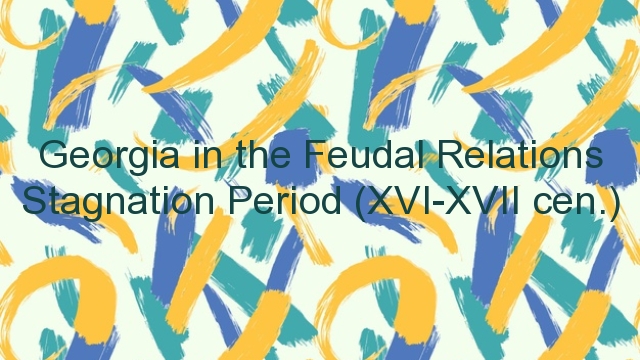
At the end of the XV cen. and in the beginning of the XVI cen. the neighbours of Georgia became two strong kingdoms – Ottoman-Turks Empire and Iran of Sephevids. They began to run the strictly expressed aggressive policy towards Georgia from the very beginning. The struggle of Georgians for independence and original culture, which lasted during 300 years began. The background of this struggle was frequent internal wars, which made the condition of politically separated Georgia worse. For example only Kartli kin gdom held 14 wars against Iran, 11 wars against Turks and 13 wars against other Georgian kingdoms in the XVI cen.
The condition especially was aggravated after Iran and Turkey made agreement on sharing Iraq, Kurdistan and Transcaucasus in 1555. According to this agreement the East part of Georgia was declared as the dominion of Iran and the West part – the dominio n of Turkey. But Georgians didn’t acknowledge this decision and still were fighting for independence. The kings of kartli, Luarsab I (1527-1556) and Simon I (1556-1599) should especially notified as the organizers of the national forced resistance in the XVI cen..
At the beginning of the XVII cen. Ottoman-Turks managed to conquer Samtskhe Princedom. The part of Samtskhe Princedom feudals accepted Islam and served Sultan. On the conquered Georgian lands there was created the Ottoman-Turkish administrative uni t – Akhaltsikhe Viliety, the governing layer of which, including governor Pashas, mainly was the representative of Georgian Feudals, who accepted Islam.
The rest of the parts of Georgia managed to retain the State system, but had to recognize the supremacy of conquerors: the kingdoms of East Georgia – Kartli and Kakheti became the vassal (subordinated) of Shah of Sephevids, the states of West Georgia became the vassals of Ottoman Sultan. But even this model of relation didn’t set peace, because conquerors longed full incorporation of Georgia, and Georgians were trying to use every chance of revival of independence.
The situation especially was aggravated in East Georgia in the first half of the XVII cen. when Shah Abbas I decided to exile Georgians to Iran or exterminate them, and to settle Iranians on their lands. The armies of Shah took 100 000 people as captiv es only from Kakheti, almost the same number of people was exterminated. After invasions of Shah Abbas there wasn’t left even one-third of the population in Kakheti. But Georgian people failed the plans of Shah with their heroic struggles. In 1625, with t he leadership of the King of Kakheti, Teimuraz I and kartlian general, Giorgi Saakadze, the active Iranian Army in Georgia was destroyed in the rebellion, Shah Abbas was forced to recognize the fact of existing of Georgian kingdoms.
The situation in East Georgia was comparatively stable from 30s of the XVII cen. when the two sides reached the compromise: the kings of Kartli and Kakheti recognized the supremacy of Iranian Shah, and the latter didn’t intervene in their internal affa irs.
Between the political units in West Georgia in the XVII cen. there were the permanent struggles, which was used by Turks to strengthen their influence. They occupied several coastal points and supported the slave-trade, the result of which was the exil e of thousands of Georgian people.
The permanent invasions of foreigners and internal wars caused the new damage for the country, weakened in the previous centuries. Economic was falling, many branches of agriculture and handicraft were destroyed, the number of population abbreviated. T hese circumstances delayed the further progress of feudal society development and in some places (especially in the highland) caused the renewal of Early feudal and patriarchal institutions.
The economical revival of the country is notified only from the 40s of the XVII cen. and only in East Georgia (Kartli), the condition of which as it was mentioned above, was comparatively stable in this period. The situation caused the positive results for the civil life. The population of Tbilisi was not more than 10 000 people at the end of the XVI cen. and in the second half of the XVII cen. it was risen to 20 000. In this period Georgia had the closest economical relations with the cities of Iran.
From the XV cen. to the XVII cen. the Georgian culture was decreased. The Georgian architecture of this period can not be compared with the brilliant examples of the X-XIII cen. In Georgia of late medieval period such high educating-scientific centres as Gelati and Ikalto didn’t exist. The education mainly was given in the families and cloisters. From the XVII cen. in the education sphere, the role of Western catholic-missioners was rising, which was establishing schools in Georgia, where there were taught as catholic preach, so Italian and Latin languages, some practical science etc.
In the XVII cen. the Georgian literature began to revive. The king Teimuraz I, who was warrior and poet, put the national-historical motive in Georgian poetry. He dedicated the poem to the death of his mother, queen Ketevan, who didn’t refuse Christian ity in the captivity of Shah and so was killed. After Teimuraz, historical theme occupied important place in Georgian poetry.
by Dr. George Anchabadze





